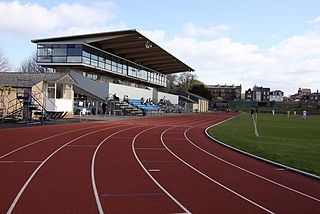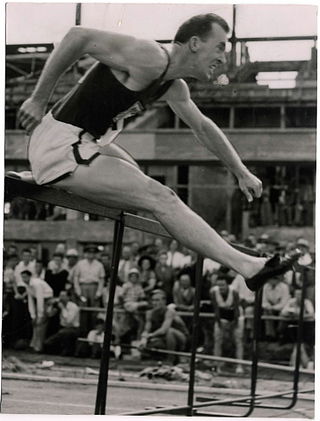Related Research Articles

Track and field is a sport that includes athletic contests based on running, jumping, and throwing skills. The name is derived from where the sport takes place, a running track and a grass field for the throwing and some of the jumping events. Track and field is categorized under the umbrella sport of athletics, which also includes road running, cross country running and racewalking.

Alvin Christian "Al" Kraenzlein was an American track-and-field athlete known as "the father of the modern hurdling technique". He was the first sportsman in the history of the Olympic games to win four individual gold medals in a single discipline at the 1900 Summer Olympics in Paris. As of 2016, Alvin Kraenzlein is the only track-and-field athlete who has won four individual titles at one Olympics. Kraenzlein is also known for developing a pioneering technique of straight-leg hurdling, which allowed him to set two world hurdle records. He is an Olympic Hall of Fame (1984) and National Track and Field Hall of Fame (1974) inductee.

Harry Livingston Hillman Jr. was one of the longest serving Dartmouth Track and Field Coaches from 1910-45, and an American track and field athlete who won three gold medals at the 1904 Summer Olympics and a silver at the 1908 Summer Olympics.

Charles Hewes Moore Jr. was an American track and field athlete, as well as a philanthropist, businessman, and champion of societal reform. Moore won a gold medal in the 400 metre hurdles in the 1952 Summer Olympics with a time of 50.8 seconds, narrowly missing the world record of 50.6 seconds. He had set the American record during Olympic qualifying. He also ran the third leg of the second-place 4×400 metres relay at the Olympics. Moore finished second for the James E. Sullivan Award for top U.S. athlete in 1952, and was selected as one of "100 Golden Olympians" in 1996. In 1999, he was inducted into the United States National Track and Field Hall of Fame. Charles Moore, an Olympics athlete of track and field died on October 8, 2020, in Laporte, Pennsylvania. He was 91 years old.

The Lillie Bridge Grounds was a sports ground on the Fulham side of West Brompton, London. It opened in 1866, coinciding with the opening of West Brompton station. It was named after the local landowner, Sir John Scott Lillie (1790–1868) and the Lillie bridge over the West London Line, that links Old Brompton Road with Lillie Road. The grounds were adjacent to the railway on the south side of Lillie Road. Although geographically near to present day Stamford Bridge, there was never direct access, there being the 13 acre now defunct Western Hospital site between the two. The ground was the scene in its day of many sports including athletics, boxing, cricket, cycling and football, and hosted the FA Cup Final in 1873. It closed in 1888 following a riot reported in The Times.
Pamela Kilborn-Ryan, AM, MBE is an Australian former athlete who set world records as a hurdler. For three years, she was ranked as the world's top woman hurdler.
Jean Catherine Pickering was a female track and field athlete from Great Britain, who competed mainly in the 80 metres hurdles and long jump.

Group Captain Donald Osborne Finlay, DFC, AFC was a British athlete and Royal Air Force officer.

The Roger Bannister running track, also known as the Oxford University track, is a 400-metres athletics running track and stadium in Oxford, England. It was where Sir Roger Bannister broke the four-minute mile on 6 May 1954, when it was known as the Iffley Road track. The track is owned and operated by the University of Oxford.

Harry Ernest Wilson was a New Zealand hurdler who competed at the 1920 Summer Olympics in Antwerp and at the 1919 Inter-Allied Games in Paris. In 1920 he finished fourth in the 110 metre hurdles competition. He was the Olympic flag bearer for New Zealand in 1920.

The USA Track & Field Outdoor Championships is an annual track and field competition organized by USA Track & Field, which serves as the American national championships for the sport. Since the year 1992, in the years which feature a Summer Olympics, World Athletics Championships, Pan American Games, NACAC Championships, or an IAAF Continental Cup, the championships serve as a way of selecting the best athletes for those competitions.

Raymond Henry Weinberg AM was an Australian athlete and coach. He was one of Australia's finest hurdlers, being ranked in the Top 8 in the world for 4 years; an Olympic finalist; in 1952 having the fastest time in the world for 220 yards hurdles; and holding the national 110 metres hurdles record for 20 years. He also held the Victorian record in the decathlon. In addition, he created, designed and had manufactured the first Australian Olympic lapel pin.

Powderhall Stadium formerly the Powderhall Grounds was a greyhound racing track in Edinburgh, Scotland. It was located on Beaverhall Road, in the Powderhall (Broughton) area of northern Edinburgh, beside the Water of Leith. The track closed in 1995 and the site is now a housing estate.

The AAA Championships was an annual track and field competition organised by the Amateur Athletic Association of England. It was the foremost domestic athletics event in the United Kingdom during its lifetime, despite the existence of the official UK Athletics Championships organised by the then governing body for British athletics, the British Athletics Federation between 1977 and 1993, and again in 1997. It was succeeded by the British Athletics Championships, organised by the BEF's replacement/successor, UK Athletics under its brand name British Athletics.
Daniel Delany Bulger was a leading Irish athlete. Along with his younger brothers, Michael Joseph Bulger (1867–1938) and Lawrence Bulger (1870–1928), he was prominent in the Irish sporting world in the late 19th century. Daniel was one of the 79 delegates who attended the Congress of the Sorbonne in Paris in 1894 that lit the flame of the Olympic Games of the Modern Era in Athens in 1896.

The 1924 Women's Olympiad was the first international competition for women in track and field in the United Kingdom. The tournament was held on 4 August 1924 in London, United Kingdom.
The 1923 WAAA Championships were the first national track and field championships for women in the UK. The tournament was held on 18 August 1923 at the Oxo Sport Grounds in London, United Kingdom.
Roxanne "Roxy" Andersen was a Canadian track and field athlete. She won a gold medal at the 1934 USA Indoor Track and Field Championships and a silver medal at the 1936 US Indoor Championships. Apart from competing in athletics, Andersen was the Pacific chair of the Amateur Athletic Union from 1950 to 1976. In 1991, Andersen was inducted into the National Track and Field Hall of Fame.
Stamford Bridge Greyhounds was the greyhound racing operation held at Stamford Bridge in London.
Omotade Ojora is a British hurdler, who won the 110 metres hurdles events at the 2021 and 2022 British Athletics Championships. He has competed in US college athletics for USC Trojans.
References
- 1 2 Barker, Philip (2013). "London Athletic club still going strong at 150 years" AIPS website. Retrieved 27 March 2013
- ↑ Cutler, Rachel (interviewer) (2002) "Miller, Richard (Part 6 of 10). An Oral History of British Athletics." British Library website. Retrieved 14 May 2014.
- ↑ Solomons, Richard. (2013) "London Athletic Club: The First 150 Years" London: London Athletic Club.
- ↑ Dickens, Charles, Jr (1879) “Dickens’s Dictionary of London: An Unconventional Handbook” London: Charles Dickens and Evans.
- ↑ Watman, Mel (1968) “History of British athletics” London: Hale ISBN 0709102550
- ↑ Lillywhite, John (1868). Football Annual. p. 78.
- ↑ "Barnes v London Athletic Club". Sportsman: 3. 21 December 1867.
- ↑ "Wanderers v London Athletic Club". Sportsman: 3. 30 November 1867.
- ↑ "Wanderers v London Athletic Club". Sportsman: 3. 15 December 1868.
- ↑ "C.C.C. v Brentwood School". The Field: 397. 14 November 1868.
- ↑ "Wanderers v A.A.C.". The Field: 335. 24 October 1868.
- ↑ "C.C.C. v Brentwood School". The Field: 397. 14 November 1868.
- ↑ Benson, Colin (1987) “The Bridge: The History Of Stamford Bridge” . London: Chelsea Football Club. ISBN 0950979813
- ↑ Culpepper Clarke, Carlo F (1934). Greyhound and Greyhound Racing. Methuen & Co Ltd (London). p. 136.
- ↑ Rye, Walter (1916). “An autobiography of an ancient athlete and antiquary”. Norwich: Roberts.
- ↑ Lucas, John A. (1972) “The First Great International Track Meet” Sports Illustrated October 23 1972 Sports Illustrated Vault website. Retrieved 27 March 2013.
- ↑ Henderson, Jason (2022). "[https://athleticsweekly.com/athletics-news/nuts-keep-history-alive-1039960407/ NUTS keep history alive" Retrieved 30 April 2023